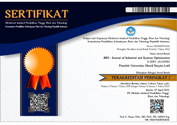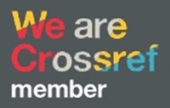LITERATURE REVIEW MODEL CIRCULAR ECONOMY DAN POTENSI PENGEMBANGANNYA
DOI:
https://doi.org/10.51804/jiso.v4i2.122-131Keywords:
Circular Economy, Indikator, Literature Review, BibliometrikAbstract
ABSTRAK
Circular Economy (CE) adalah konsep yang mendorong penggunaan sumber daya yang sirkular untuk mencapai perkembangan yang sustainable. Topik CE sedang berkembang dengan pesat dan menarik perhatian berbagai pihak baik pemerintah, pelajar maupun dunia usaha dan industri. Artikel ini akan mengkaji secara kongkrit mengenai indikator-indikator untuk mengukur efisiensi ekonomi dalam konsep Circular Economy (CE). Sebuah analisis Bibliometrik juga dibangun untuk memaparkan perkembangan pendekatan CE dengan dukungan database scopus. Konsep Circular Economy ini membahas berbagai langkah dan strategi untuk menghemat fungsi dari produk, komponen, material dan lain-lainnya. Kebutuhan literature review untuk perkembangan model CE sangat dibutuhkan oleh peneliti, industri dan pemerintah. Pengembangan model CE juga perlu membahas kebutuhan tersebut dengan mempertimbangkan dampak pada lingkungan, kompetisi ekonomi, dan kelangkaan sumber daya. Selain itu, artikel ini juga diharapkan dapat memberikan pemahaman CE yang kongkrit sebagai peletakan dasar pengukuran dari implementasi CE yang telah dilakukan oleh berbagai pihak
ABSTRACT
Circular Economy (CE) is a concept that encourages the use of circular resources to achieve sustainable development. The topic of CE is proliferating and attracting the attention of various parties, including the government, students, businesses and industry. This article will examine in a concrete way the indicators to measure economic efficiency in the Circular Economy (CE) concept. Bibliometric analysis was also built to describe the CE approach's development with the Scopus database's support. This Circular Economy concept discusses various steps and strategies to save the function of products, components, materials and others. Researchers, industry and government urgently need a literature review for developing the CE model. The development of the CE model also needs to address these needs, considering the impact on the environment, economic competition, and resource scarcity. In addition, this article is also expected to provide a concrete understanding of CE as a basis for measuring the CE implementation that various parties have carried out.
References
Almulhim, A. I., & Abubakar, I. R. (2021). Understanding Public Environmental Awareness and Attitudes toward Circular Economy Transition in Saudi Arabia. Sustainability, 13(18), 10157. https://doi.org/10.3390/su131810157
Bjørnbet, M. M., Skaar, C., Fet, A. M., & Schulte, K. Ø. (2021). Circular economy in manufacturing companies: A review of case study literature. Journal of Cleaner Production, 294, 126268. https://doi.org/10.1016/j.jclepro.2021.126268
Bobba, S., Mathieux, F., Ardente, F., Blengini, G. A., Cusenza, M. A., Podias, A., & Pfrang, A. (2018). Life Cycle Assessment of repurposed electric vehicle batteries: an adapted method based on modelling energy flows. Journal of Energy Storage, 19, 213–225. https://doi.org/10.1016/j.est.2018.07.008
Borrello, M., Caracciolo, F., Lombardi, A., Pascucci, S., & Cembalo, L. (2017). Consumers’ Perspective on Circular Economy Strategy for Reducing Food Waste. Sustainability, 9(1), 141. https://doi.org/10.3390/su9010141
Boulding, K. E. (1986). What Went Wrong with Economics? The American Economist, 30(1), 5–12. https://doi.org/10.1177/056943458603000101
Busu, M., & Trica, C. L. (2019). Sustainability of Circular Economy Indicators and Their Impact on Economic Growth of the European Union. Sustainability, 11(19), 5481. https://doi.org/10.3390/su11195481
Cai, H., & Fan, R. (2019). Regional Total Factor Energy Efficiency Evaluation of China: The Perspective of Social Welfare. Sustainability, 11(15), 4093. https://doi.org/10.3390/su11154093
Cayzer, S., Griffiths, P., & Beghetto, V. (2017). Design of indicators for measuring product performance in the circular economy. International Journal of Sustainable Engineering, 10(4–5), 289–298. https://doi.org/10.1080/19397038.2017.1333543
Dagevos, H., & Lauwere, C. de. (2021). Circular Business Models and Circular Agriculture: Perceptions and Practices of Dutch Farmers. Sustainability, 13(3), 1282. https://doi.org/10.3390/su13031282
Diddi, S., & Yan, R.-N. (2019). Consumer Perceptions Related to Clothing Repair and Community Mending Events: A Circular Economy Perspective. Sustainability, 11(19), 5306. https://doi.org/10.3390/su11195306
Fassio, F., & Minotti, B. (2019). Circular Economy for Food Policy: The Case of the RePoPP Project in The City of Turin (Italy). Sustainability, 11(21), 6078. https://doi.org/10.3390/su11216078
Fletcher, C. A., & Dunk, R. M. (2018). In The Search For Effective Waste Policy: Alignment Of Uk Waste Strategy With The Circular Economy. Detritus, In Press, 1. https://doi.org/10.31025/2611-4135/2018.13740
Frérot, A. (2014). Circular economy and resource efficiency: a driver of economic growth in Europe. The Fondation Robert Schuman – Policy Report, European I(no 331), 8.
Garza-Reyes, J. A., Kumar, V., Batista, L., Cherrafi, A., & Rocha-Lona, L. (2019). From linear to circular manufacturing business models. Journal of Manufacturing Technology Management, 30(3), 554–560. https://doi.org/10.1108/JMTM-04-2019-356
Geissdoerfer, M., Savaget, P., Bocken, N. M. P., & Hultink, E. J. (2017). The Circular Economy – A new sustainability paradigm? Journal of Cleaner Production, 143, 757–768. https://doi.org/10.1016/j.jclepro.2016.12.048
Georgantzis Garcia, D., Kipnis, E., Vasileiou, E., & Solomon, A. (2021). Consumption in the Circular Economy: Learning from Our Mistakes. Sustainability, 13(2), 601. https://doi.org/10.3390/su13020601
Ghisellini, P., Cialani, C., & Ulgiati, S. (2016). A review on circular economy: the expected transition to a balanced interplay of environmental and economic systems. Journal of Cleaner Production, 114, 11–32. https://doi.org/10.1016/j.jclepro.2015.09.007
Graedel, T. E., Allwood, J., Birat, J.-P., Buchert, M., Hagelüken, C., Reck, B. K., Sibley, S. F., & Sonnemann, G. (2011). What Do We Know About Metal Recycling Rates? Journal of Industrial Ecology, 15(3), 355–366. https://doi.org/10.1111/j.1530-9290.2011.00342.x
Hertwich, E., Lifset, R., Pauliuk, S., & Heeren, N. (2020). Resource Efficiency and Climate Change: Material Efficiency Strategies for a Low-Carbon Future. Hertwich, E., Lifset, R., Pauliuk, S., Heeren, N. A report of the International Resource Panel. United Nations Environment Programme, Nairobi, Kenya. In United Nations Environment Programme. https://doi.org/10.5281/zenodo.3542680
Jackson, S. J. (2019). Repair as Transition: Time, Materiality, and Hope. In Repair Work Ethnographies (pp. 337–347). Springer Singapore. https://doi.org/10.1007/978-981-13-2110-8_12
Kalmykova, Y., Sadagopan, M., & Rosado, L. (2018). Circular economy – From review of theories and practices to development of implementation tools. Resources, Conservation and Recycling, 135, 190–201. https://doi.org/10.1016/j.resconrec.2017.10.034
Kirchherr, J., Reike, D., & Hekkert, M. (2017). Conceptualizing the circular economy: An analysis of 114 definitions. Resources, Conservation and Recycling, 127, 221–232. https://doi.org/10.1016/j.resconrec.2017.09.005
Korhonen, J., Nuur, C., Feldmann, A., & Birkie, S. E. (2018). Circular economy as an essentially contested concept. Journal of Cleaner Production, 175, 544–552. https://doi.org/10.1016/j.jclepro.2017.12.111
Lakatos, E., Dan, V., Cioca, L., Bacali, L., & Ciobanu, A. (2016). How Supportive Are Romanian Consumers of the Circular Economy Concept: A Survey. Sustainability, 8(8), 789. https://doi.org/10.3390/su8080789
Lakatos, E. S., Yong, G., Szilagyi, A., Clinci, D. S., Georgescu, L., Iticescu, C., & Cioca, L.-I. (2021). Conceptualizing Core Aspects on Circular Economy in Cities. Sustainability, 13(14), 7549. https://doi.org/10.3390/su13147549
Lauten-Weiss, J., & Ramesohl, S. (2021). The Circular Business Framework for Building, Developing and Steering Businesses in the Circular Economy. Sustainability, 13(2), 963. https://doi.org/10.3390/su13020963
Liu, Y., Zhang, Y., Batista, L., & Rong, K. (2019). Green operations: What’s the role of supply chain flexibility? International Journal of Production Economics, 214, 30–43. https://doi.org/10.1016/j.ijpe.2019.03.026
Moreau, V., Sahakian, M., van Griethuysen, P., & Vuille, F. (2017). Coming Full Circle: Why Social and Institutional Dimensions Matter for the Circular Economy. Journal of Industrial Ecology, 21(3), 497–506. https://doi.org/10.1111/jiec.12598
Moriguchi, Y. (2007). Material flow indicators to measure progress toward a sound material-cycle society. Journal of Material Cycles and Waste Management, 9(2), 112–120. https://doi.org/10.1007/s10163-007-0182-0
Murray, A., Skene, K., & Haynes, K. (2017). The Circular Economy: An Interdisciplinary Exploration of the Concept and Application in a Global Context. Journal of Business Ethics, 140(3), 369–380. https://doi.org/10.1007/s10551-015-2693-2
Niskanen, J., McLaren, D., & Anshelm, J. (2021). Repair for a Broken Economy: Lessons for Circular Economy from an International Interview Study of Repairers. Sustainability, 13(4), 2316. https://doi.org/10.3390/su13042316
Padilla-Rivera, A., Russo-Garrido, S., & Merveille, N. (2020). Addressing the Social Aspects of a Circular Economy: A Systematic Literature Review. Sustainability, 12(19), 7912. https://doi.org/10.3390/su12197912
Peattie, K. (2010). Green Consumption: Behavior and Norms. Annual Review of Environment and Resources, 35(1), 195–228. https://doi.org/10.1146/annurev-environ-032609-094328
Prendeville, S., Cherim, E., & Bocken, N. (2018). Circular Cities: Mapping Six Cities in Transition. Environmental Innovation and Societal Transitions, 26, 171–194. https://doi.org/10.1016/j.eist.2017.03.002
Rossi, E., Bertassini, A. C., Ferreira, C. dos S., Neves do Amaral, W. A., & Ometto, A. R. (2020). Circular economy indicators for organizations considering sustainability and business models: Plastic, textile and electro-electronic cases. Journal of Cleaner Production, 247, 119137. https://doi.org/10.1016/j.jclepro.2019.119137
Ruggieri, A., Braccini, A., Poponi, S., & Mosconi, E. (2016). A Meta-Model of Inter-Organisational Cooperation for the Transition to a Circular Economy. Sustainability, 8(11), 1153. https://doi.org/10.3390/su8111153
Sánchez-Ortiz, J., Rodríguez-Cornejo, V., Del Río-Sánchez, R., & García-Valderrama, T. (2020). Indicators to Measure Efficiency in Circular Economies. Sustainability, 12(11), 4483. https://doi.org/10.3390/su12114483
Smol, M., Duda, J., Czaplicka-Kotas, A., & Szo?drowska, D. (2020). Transformation towards Circular Economy (CE) in Municipal Waste Management System: Model Solutions for Poland. Sustainability, 12(11), 4561. https://doi.org/10.3390/su12114561
Sverko Grdic, Z., Krstinic Nizic, M., & Rudan, E. (2020). Circular Economy Concept in the Context of Economic Development in EU Countries. Sustainability, 12(7), 3060. https://doi.org/10.3390/su12073060
Tetra Tech ES, I. (2021). Clean energy and the circular economy: opportunities for increasing the sustainability of renewable energy value chains: Scaling Up Renewable Energy (SURE) (Issue October).
The Ellen MacArthur Foundation. (2012). Towards a circular economy: Business rationale for an accelerated transition.
Tserng, H.-P., Chou, C.-M., & Chang, Y.-T. (2021). The Key Strategies to Implement Circular Economy in Building Projects—A Case Study of Taiwan. Sustainability, 13(2), 754. https://doi.org/10.3390/su13020754
Verme?an, H., Mang?u, A., & Tiuc, A.-E. (2020). Perspectives of Circular Economy in Romanian Space. Sustainability, 12(17), 6819. https://doi.org/10.3390/su12176819
Downloads
Published
Issue
Section
License
With the receipt of the article by JISO Editorial Board and the decision to be published, the copyright regarding the article will be transferred to JISO. The copyright transfer form can be downloaded here.
JISO has the right to multiply and distribute the article and every author is not allowed to publish the same article that was published in this journal.
JISO is licensed under a Creative Commons Attribution-ShareAlike 4.0 International License.
Under the following terms:
Attribution — You must give appropriate credit, provide a link to the license, and indicate if changes were made. You may do so in any reasonable manner, but not in any way that suggests the licensor endorses you or your use.
ShareAlike — If you remix, transform, or build upon the material, you must distribute your contributions under the same license as the original.














